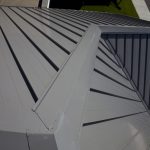2019 Metal Construction Hall of Fame

J. David Clapperton
J. David Clapperton’s expertise in, and approach to, construction was so impactful it left enduring effects that went beyond his company to the metal construction industry.
The former vice president of operations at Austell, Ga.-based fabricator and installer MillerClapperton contributed to a technical document that set industry standards, mentored numerous project managers and others in the industry, and had a reputation for conducting himself and his business with a high level of honesty and accountability.
While Clapperton’s efforts left lasting effects on MillerClapperton’s growth and the built environment, his sharing of knowledge, relationships with workers and truthful business conduct changed the metal construction industry for the better.
Advancing, Defining Rainscreens
Clapperton, who retired in 2017 and passed away in January 2019, and his business partner, Ted Miller, grew MillerClapperton from a two-person brokerage company in 1979 into a large fabrication and installation company. Over the course of his career, Clapperton’s company was one of many that put forth an increasing amount of rainscreens with metal composite material (MCM) panels. MillerClapperton was among the first companies to offer Reynobond MCM in the early 1990s. Terminology used to designate how different rainscreen designs worked evolved alongside technological advances. Clapperton helped define rainscreen types for the metal construction industry through his contributions to a technical document, volunteering on the Metal Construction Association’s (MCA’s) rainscreen task force and other efforts.
Drain back-ventilated rainscreens are more achievable than pressure-equalized rainscreens, and misinformation about them was being distributed, says Zeke Miller, president at MillerClapperton. Clapperton’s work on the technical document, a white paper titled “Understanding The Rainscreen Principle,” published in 2006 for MCA, addressed water infiltration and management in the wall systems. It helped clarify the issues and educate stakeholders.
As rainscreens with MCM increased in use, some companies claimed to offer pressure-equalized rainscreens when they were, in fact, offering drain back-ventilated rainscreens, Zeke Miller says. “[Some companies] thought all you had to do for a pressure-equalized rainscreen attachment system was put vent holes in the bottom flanges of all the panels, and that would create the proper amount of airflow to reach pressure equalization when a wind load was applied to a wall. In fact, that’s not the case. A pressure-equalized rainscreen attachment system is dependent on compartmentalization behind the panel. The compartments change on every single job depending on cavity depth, size of panel, size of the compartments that you can create, and the white paper helped tell that story.”
Scott Stafford, senior estimator at MillerClapperton, who worked with Clapperton beginning in 1997, says Clapperton’s contributions to MCA’s rainscreen task force and white paper provided clarity in the metal construction industry. “[Clapperton] did exhaustive research into codes and regulations to help clear the confusion that was pervasive on the subject at the time.”
What was important to [Clapperton] about the construction industry was [he] always strived to deliver the highest possible quality and to operate with total integrity. He never shorted anybody on either one of these.
Zeke Miller, MillerClapperton
Guidance with Expectations
Clapperton maintained a steadfast work ethic, and held similarly high expectations for his employees. He was punctual and precise, often calculating construction measurements to four decimal places. He was often the first person to start working and the last one to leave at the end of the day, Zeke Miller says. Those who Clapperton mentored, who knew him as Dave, followed his lead.
Indeed, Zeke Miller was one of numerous workers Clapperton mentored. When he started working at MillerClapperton part-time performing janitorial duties while he was in high school in the late 1980s, he reported to Clapperton. And he continued reporting to him as he rose through the ranks of estimator, sales, sales manager and president.
“[Clapperton’s] attention to detail will never be matched; he’s the most detailed person that I have ever met,” Zeke Miller says.
Over the years, Clapperton trained and managed numerous project managers, some who stayed at the company and others that continued his work ethic and precise approach at other companies.
“There have been many guys specifically in project management that have moved onto other companies that were under his management that he made better project managers because he demanded so much excellence and effort,” Miller says. “Their worth when they left was more than when they came here just simply because they were under his tutelage.”
Legacy of Ethics
Clapperton had a reputation for being honest and forthcoming with everyone he encountered, including employees and customers. “What was important to [Clapperton] about the construction industry was [he] always strived to deliver the highest possible quality and to operate with total integrity,” Zeke Miller says. “He never shorted anybody on either one of these.”
Clapperton’s ethical standards helped build the bedrock of business that he and Ted Miller amassed over three decades. During that time, the company grew from a small operation with just the two of them, to a company that performed its own fabrication and installation, to a large company that completed more than 100 projects in 2018.
Even when outcomes were not ideal, Clapperton adhered to his ethical approach. For instance, when one project about 20 years ago did not go as planned, and devolved into disagreements among project team members, Clapperton insisted his company take responsibility for its actions that let to the dispute.
“[Clapperton] explained to [our attorney] the problem, he was completely transparent with both him and the other firm’s attorney our culpability in the situation,” Stafford says.
“We weren’t running from that involvement, or what we did to get our customer and ourselves in that situation,” Zeke Miller says.
Clapperton’s example of conducting business ethically in this situation and others left lasting impacts on Stafford, Zeke Miller and many others inside and outside his company. MillerClapperton’s core values continue reflecting Clapperton’s approach, Zeke Miller says.
“We were taught to always do the right thing no matter what the cost, and oftentimes the right thing was costly. But we did, and still do that without hesitation today. We just do the right thing and admit our fault and come to an amicable agreement with the customer, and move on. We try to maintain the highest level of integrity in everything we do, no matter what the cost; it’s one of our core values.”






